| History
Special features
The Oracle
The Chariot
About Manjeswar
|
 |
Sree Ananteshwar
Temple is situated in Manjeswar, a small town near Kasargod in Northern Kerala. It is the
most ancient and the most important temple of GSBs of Kerala supposed to be existing since
the 2nd century A.D. This temple was traditionally renowned as Manjula
Kshetra and The Temple of 18 towns, indicating that for the GSB settlements
of 18 different places this was the only temple available. The temple has hills on three
sides and river Manjeshwar flowing by the other. The temple is about 1½ km from Manjeswar
Railway station and a Kashi mutt branch is located near to the temple. |

click for google location map of
the temple
|
Main deities
The temple has three principal deities, Shri
Ananta, Shri Ishwar (Siva) therefore Shri Ananteshwar
and Lord Bhadra Narasimha (an avatar of Vishnu).
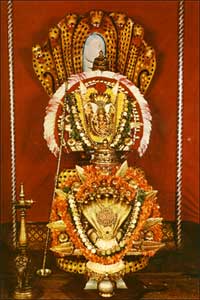 The
original temple had a swayambu Siva lingam, and later Ananta also was installed
there making it the Ananteswar temple. However, with the installation of Sri Bhadra
Narasimha in the 12th century, the Temple has become a major pilgrimage center for
Vaishnavits. There is also a legend that Lord Siva himself installed the image of
Narasimha here for the worship of mortals in Kaliyuga. The
original temple had a swayambu Siva lingam, and later Ananta also was installed
there making it the Ananteswar temple. However, with the installation of Sri Bhadra
Narasimha in the 12th century, the Temple has become a major pilgrimage center for
Vaishnavits. There is also a legend that Lord Siva himself installed the image of
Narasimha here for the worship of mortals in Kaliyuga.
Lord Mukhyaprana, Lord Rudra, Devi Laxmi,
Lord MahaGanapathy and Lord Garuda are the other deities in the Temple. The image of Shri
Subramanya is installed in a declivity considerably lower than the surrounding area and
full of serpent holes. |
Special Features
| The Ant hill Inside the Sanctum Sanctorum and behind the throne
of Divine Idols, there exists an ant hill called "ROHINI" or "RUWANI".
This provides "Prasadam" in the form of white coloured soil. The Soil of ROHINI
is believed to possess the biotic power and is everlasting in spite of continuous
extraction for centuries
The Sesha Tirtham
On the right side of
the Temple, is a small pond known as Sesha Tirtham. Legend says that Leprosy patients used
to take bath in the Sesha Tirtha and cured. |
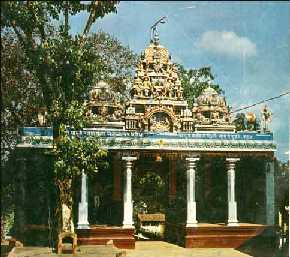
Gopuram at the temple entrance
|
The Oracle
Another special feature is the DARSHAN
reminiscent of the Greek Oracle, when it is believed, the Shesha reveals Himself to His
devotees in the person of a priest who is the eldest surviving descendant of Ranga Sharma,
who installed the Sesha or Ananta idol at the Temple, and solves the knotty problems and
prophesies the future, of the devotees and sometimes bestows boons on them. No wonder, the
Temple has gained wide popularity not only among the Gowda Saraswaths, but among other
Hindus also, as is evidenced by the fact that of the three thousand and odd permanent
endowments to the Temple, nearly three hundred are by non Gowda Saraswats.
The Oracle is not in practice since 1935 and
efforts are being made to reinstate the Oracle. The history of the Temple has an exciting
narration about a devotee who was able to realise his dreams of visiting Shri Tirumala
Tirupati Temple and praying to Lord Venkatramana, by experiencing the event by the grace
of the Oracle.
Shri Jogi Gana
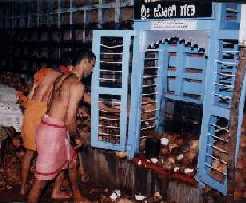
|
A group of Holy
Spirits known as Ganas or Bhootha Ganas surround the precincts of the Temple. These are
represented by appropriate sized granite stones located in the inner and outer rounds of
the Temple. Legend says that these Ganas were established by the famous Oracle. |
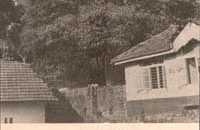
Place of Jogi Gana (an old pic)
|
The Jogi Gana situated in the north eastern side
of the Temple is said to be the leader of these Ganas.
Coconuts are the main offering to the Gana.
Devotees vow to offer a coconut when valuables are stolen or misplaced during normal times
and also in religious functions at home.
The Chariot
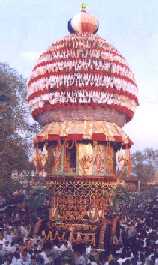 |
Of
the many festivals in the Temple, the annual Car festival which falls on the sixth day of
the bright half of the month of Nov / Dec is the most important. The day is known in
popular parlance as the Manjeshwar Shasti and coincides with
"Skhanda Shasti" in other parts of South India. On that day, the six - wheeled
chariot called Brahma Ratha is pulled along the Car Street.
The Lord's Chariot reverently called BrahmaRatha is a magnificent edifice made
out of wood. The originar Chariot was looted by Raja of Vittal in 1799 and the
present one was built in the year 1834 A.D and has a base of 17 ft, maximum girth of
53 ft and raises to the height of 71 ft. when it is decorated with flags, flowers and
other accessories during the annual festival. About 75 people can be accommodated on the
Chariot.
The Lords Idol is taken up the steps of the
Chariot and thousands of people pull the magnificent Chariot with shouts of Govinda-Govinda
as it rolls along the car street majestically. The chariot is decorated on the lines
followed in the other parts of Dakshin Kannada district. |
It is a custom at the Temple
that the Ratharohan i.e. taking the Lords idol up into chariot must be completed before
sunset. Accordingly the chariot festival takes place in the evening itself.
Construction: Across the four pillars, crossbeams are tied to which circular bamboo
strip is tied. Above the main structure, wooden planks are placed in Jalandhar fashion,
and to this wooden strips are tied bringing about a circular shape or kalasha and
decorated with small cloth flags of red and white colour. The sides of the chariot and
above are decorated with paintings of divine images. In the center of the chariot, a
wooden platform is built on which the Lords throne is placed. Above the upper structure
decorated with flags, a similar round structure enclosed with colourful cloth is
constructed on which the Suvarna Kalasha (i.e a round vessel of golden emblem) is
positioned. Inside the chariot and around the Lords throne, about 60 persons can be
accommodated. |
History The
Legends and historic events trace the existence of this Temple for more than one thousand
years. It originally had a Siva Lingam. A chapter in the Purana is devoted to the
pilgrimage of a saint called Virupaksha of the Gowda Saraswat Community to the holy
shrines in South Inda, says that the saint settled down in Manjeshwar and spent his last
days there worshipping the image of Sri Siva and finally attaining 'Moksha'. The original
temple fell in ruins and remained so for years.
Later according to the epic of the place one
Ranga Sharma, a Gowda Saraswat Brahmin of Goa, on his way to Rameshwaram halted here at a
place called "Shankhamale". He accidentally came across the ruins of this
Temple. Soon he rebuilt the Temple, as guided by Lord Shiva in his dreams and installed
the Idol of "Shesha" which he had brought with him from Goa, along with the
original Idol of Lord Shiva.
Mention is made in "Manjula Mahathmya"
of the Sahyadri-Khand in the Skanda Purana, of Sri Siva Himself having installed the image
of Narasimha here for the worship of mortal in Kaliyug.The image of Shri Narasimha
in the Temple as it exists today is made of "Panchaloha" (Five Metals)
and has been installed in the place of the old one, in the 12th century A.D.
The "Pancha Ratra" mode of religious
service, one of the prescribed "Agamas" now observed in the Temple was
introduced by Shri Raghavendra Thirtha the 5th spiritual head of Kashi mutt.
There is a belief that Shri Narasimha gave "Darshan" to the Swamiji. Today,
there is a Mutt belonging to Kashi Mutt Samsthan adjacent to the Temple.
This Temple like many other ancient Temples fell
a prey to the ravages of man and nature. In 1677, a cyclone devastated certain portions of
the Temple. It was looted by one Muhamed Ali, the ruler of Cannanore and immediately after
by a Maharatha pirate, Angira in about 1755 A.D. In 1799, after the fall of Tippu Sultan
who had held sway over South Canara and with the consequent coming into power of Heggade,
the Ruler of Vittal (22 miles east of Manjeswar), the armed forces Vittal under one Mavla
forced into the temple and carried away a large booty including idols, jewels, copper and
a temple chariot. The temple Accountant was tourtured to divulge the treasures
hidden in the temple, and having succeeded in locating them, the valuables were dug up and
taken away. However as a result of the representations made by the Gowda Saraswats to the
British authorities, the ruler of Vittal was captured and the properties looted by him
were restored to the Temple. In 1804, it was renovated by the Gowda Saraswat Brahmins and
a new image of Shri Narasimha known as Shri Bhadra Narasimha was installed by Sri
Vibhudendra Tirtha, the then head of the Kashi Mutt.
Social work
Besides being a religious center, the temple has
proved itself a beacon light of learning and social welfare. It runs a full- fledged high
school, an elementary school, a Library with books on religion and Philosophy, a choultry
with all amenities for pilgrims and a hall called Ananda-Kalyana-mandapapam for
conducting marriages, Upanayanams, Annaprasanam and other socio-religious functions. In
addition, it provides scholarships for school and university education. Special mention
has to be made of free distribution of rice to Harijans on Saturdays. Protection and
welfare of cattle is another activity.
About Manjeswar click for Kasargod district map
Manjeswar is a place of historical and religious
importance. A number of temples and fifteen mosques make
this cashew growing town a prominent pilgrim centre. The memorial of the late Sri Govinda
Pai, the grand patriarch of kannada literature, is situated at Manjeswar. At
Kanwatheeratha beach (3 km from Manjeswar), a large swimming pool-like formation of the
sea on the vast beach is a gift of nature. There are two old Jain Bastis at Bengara
Manjeswar on the southern bank of the Manjeswar River.
|
|
